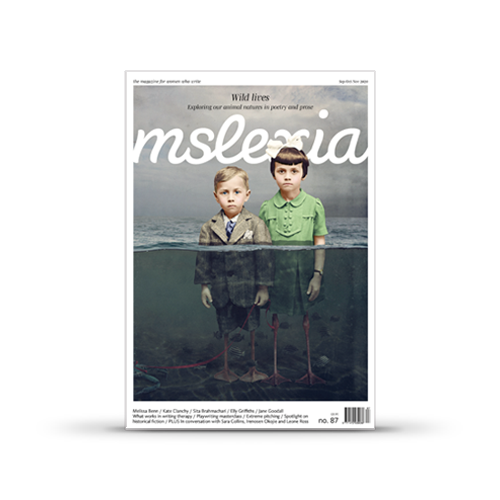
If you want feedback and advice on pitching then join us in the Salon this February where editor Debbie Taylor undertakes two pitch surgeries ahead of our Agent Extravaganza!
When I set myself this rather arbitrary challenge, I had no idea it would transform my creativity – and my confidence.
After a period on staff at a magazine, I returned to the world of freelance writing on the same day that Boris Johnson announced the UK was going into lockdown. Suddenly I was not only working for myself again but also, along with the rest of the nation, unmoored from the usual structures of everyday life. At the same time, the pandemic created turmoil within the publishing industry, with redundancies, furloughing, budget cuts and changes to schedules as well as content.
A few whirlwind weeks later, I knew I needed a greater sense of routine and structure. I wanted an anchor point for my working day, an activity that I could concentrate on regardless of the outside world. The idea for my May pitching challenge was born: I would write and submit a pitch for an article every single day that month.
That meant every day: no skipping weekends, no missing out the Bank Holidays, no getting to the end of the month and catching up with any days I’d missed.
The premise was simple. As a freelancer trying to earn a living, I’m constantly looking for ways to generate more work. Pitching every day for a month would force me to cast my net more widely than usual, contacting new editors and trying out different angles on familiar topics (I specialise in sustainability and ethical living).
At the same time, the challenge would keep my focus on an aspect of my work that I could control. As a long-time listener of the #AmWriting podcast, I’d often heard the hosts, authors Jessica Lahey, K J Dell’Antonio and Sarina Bowen, discuss the importance of setting goals that are within our power to achieve. Sage advice.
Although the overall challenge felt like the definition of a Sisyphean task, the daily task required – write a pitch, send a pitch – was the basic bread-and-butter of freelance writing. I already knew how to do it. What I wanted was for this small daily action to build into a bigger habit that I would continue even when the month was over.
However, best-selling author Gretchen Rubin, who has written extensively about habit formation, issues a warning about the boot camp approach: beware the hidden danger of finish lines. ‘Setting a finish line does indeed help people reach a goal’, she explains. ‘But although it’s widely assumed to help habit-formation, the reward of hitting a specific goal can undermine habits. A finish line marks a stopping point, and once we stop, we must start over, and starting over is harder than starting’ (her emphasis). What I did in June would, therefore, be as crucial to the success of my challenge as the month of May itself.
I approached the first day with trepidation. What if I ran out of ideas? Would the pressure quash my creativity? Yet as soon as I actually got started, the challenge felt like a marriage of productivity and creativity.
My mantra ‘digital for productivity; analogue for creativity’ soon came into its own. I had a spreadsheet to record what I’d pitched, when and to whom; I also scrawled pages and pages of lists, notes and half-formed ideas in my Moleskine. During one brainstorm I jotted down topics ranging from the joys of inter-generational friendship, to the experience of being a homework-helping auntie in lockdown, to the environmental impact of condoms (alas none of these came to fruition).
One Saturday, when I couldn’t settle on which idea to develop next, my partner suggested pitching about the pitching challenge itself (you’re reading the result of that now).
I’d started May with a tangible quantified goal and needed creativity to achieve it. Ten days in, my creativity kicked in and I discovered I needed the structure of the pitching challenge to channel and make use of it. Come the end of the month, I’d learnt three major lessons.
From the outset, I’d wanted to build relationships with editors I hadn’t worked with before. I’d done this previously, but returning to my pitching challenge spreadsheet day in, day out, made me much more consistent in my efforts than in the past. For example, I already knew that starting a conversation could lead to opportunities. Now I was in more frequent contact with new editors, the tips and tricks that would encourage a back-and-forth exchange rose to the forefront of my mind – and stayed there. In particular, I became diligent about replying to every response with the question, ‘Are you looking for pitches on any specific subjects at the moment?’. With so many editors now overseeing a portfolio of publications, those simple words can make a big difference – and led to two unexpected commissions for magazines I had never even thought about pitching to.
Of course, for every editor that said ‘yes’, there were several (or more) who said ‘no’ – or worse still didn’t respond at all. But I found focusing on the pitch, rather than the result of the pitch, helped ease the sting of rejection. I might wallow for a while, but I still pitched again the following day. That commitment to filling out my spreadsheet every day strengthened my resilience; regularly muttering ‘rejection is an inevitable part of the job’ whilst forcing a cheery smile may have helped too. The only writer who has never been rejected is one who has never submitted.
Another lesson was discovering that ideas are like renewable energy. Needing a new one every day broke my bizarre habit of hoarding what I viewed as the best ideas, saving them for some unspecified future occasion. Instead I pitched them and discovered I didn’t run out of inspiration; on the contrary, my imagination flourished. Like solar and wind power, ideas kept being generated.
At the same time, I felt the responsibility of being a good steward of these resources. Although the ideas kept coming, it was still important to use them as best I could. In practice, this meant looking for ways to make the most of an idea by reusing a specific element or finding another angle. For instance, I conducted an interview for one article then pitched another piece based on some of the unused material from that discussion.
I also discovered that I needed to be both proactive and reactive in my approach. I dedicated time to researching potential articles. I considered whether I could update aspects of previous work I’d written, or address a different audience with the same material, or link the material to a new topic.
Needing a new target each day also made me more alert to tweets from commissioning editors, and I studied freelance writing jobs newsletters with renewed vigour. I became more responsive to statements and events as well. When the fashion industry made an announcement about sustainability, I was quick off the mark in pitching an opinion piece (albeit with no success). And I contacted a local newspaper with a story idea on the back of a press release, although that didn’t work out either.
Toward the end of the challenge, I began to run out of steam. I pitched on the first Bank Holiday of the month, but not the second. My brain needed a break, so I took some weekend days off, despite my resolve not to. Overall, however, I pitched more days than not and by the end of the month I had submitted over 30 article ideas to editors.
And I have pitched pretty much every weekday since. My record is not perfect, but I haven’t fallen foul of the dreaded finish line mindset. I now simply assume that I will pitch every day, which I didn’t do before. Pitching has become as much part of my job as the actual writing – and the inevitable invoice chasing.
Was the challenge a success? Yes, definitely. Though I received more ‘Thanks but no thanks’ responses than I did commissions, it generated work too. I’ve now written for four titles that I had never pitched to before and have built relationships with several new-to-me editors. More importantly, I have reclaimed a sense of agency. In a tough market, I channelled my energies into an aspect of my work that I could control. I focused on what I could do, and I did it.
TRY THIS
CRAFTING A JOURNALISM PITCH
Here are some tips I’ve gleaned from experts in this field.
- ‘Read as if your livelihood depends on it. Read who you are pitching to. Stay abreast of what they are covering now, which might be different from what they’ve already done’
- Don’t panic pitch and let the quality drop. Ensure it is a sustainable story with an arc, and make sure the editor doesn’t need to come back asking obvious questions’ Heidi Scrimgeour and Hazel Davis, creators of the Muse Flash pitching courses
- ‘Seek out rejection. You have nothing to lose but your pride – and so much to gain’ Donna Ferguson, a freelance journalist who runs pitching workshops for Women in Journalism and others
- My advice? Use a template. I always include a suggested headline and a sell (what it is, why it’s interesting), and bullet points of the main issues I plan to cover.
- Follow up a couple of days later, and maybe again after that, with a short and polite ‘Did you see this?’ email. Usually it comes to nothing, but occasionally it leads to a commission – as it did with this article.
This article originally featured in Issue 87 of Mslexia.


